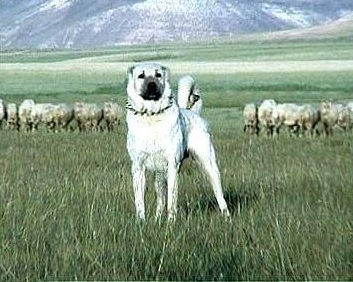
According to Bijan Eliasi, Director of Kurdish Worldwide Resources:

"Kangal
dog is a native breed from the Kangal area in northwest Kurdistan in Turkey. It
is known as "Gammal" to every Kurdish child. It is inaccurate to call this dog a
"Turkish breed," for the following reasons: The nomadic Turkish tribes did not
arrive in these areas of Anatolia (modern Turkey) until after the Battle of
Manzikert in AD 1072, that is, about 800 years ago. However, the Kurds had been
residing in the same geographical region--Kurdistan--for many thousands of
years. Their name as the native population of there is recorded as early as
3,100 yeas ago in the inscriptions of king Tiglath-pileser I. This simple
chronology alone should overturn the present designation of the Kangal
breed as a "Turkish" breed."
Kurd at "Zozan"...

The Kengal is a cherished dog among Kurds. It
is celebrated for it's strenght and loyalty. Kurds are a people with strong
agricultural customs and traditions. Their lifestyle has evolved from a
semi-nomadic to a sedentary lifestyle - still keeping traditions like going to "Zozan"
(Kurdish for "highlands;" as shown in picture) with their sheep. The place where
they put up their tent and the surrounding area is called "War" - here they will
stay through the summer to avoid the hot climate and come back down to their
villages in autoum when it starts getting cool again.
A Kurdish family is usualy quite large in
size. Consisting from 4 to 8 children. This is especially true in the rural
areas, where there is a lot of work at the farm and the parents need help with
the cattle, sheep, ochyard, corn etc. and all the work that is involved. Kurds
have a tradition of making youghurt of milk from sheep.
The Kengal has always played an important role
in looking after the herd and protecting their masters from wolves, bears etc.
It is not unusual for the Kengal to have a barbed leash - as shown in the
picture above. In Kurdistan a dog isn't brought inside a house, most probably
because of hygiene. They usually sleep under the open sky or in their
doghouse... If they have one!
In the map below you can see where the Kangal
can be found in Eastern Kurdistan. However, although I am only found a map for
their where abouts in Eastern Kurdistan, the Kangal can be found in all of
Kurdistan - from Siwas in North-western Kurdistan and all the way to Pahve in
South-eastern Kurdistan. It is a nationally recognized loyal subject of the
Kurds and has as Bijan Eliasi describes been so for thousands of years.